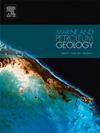Do hydrothermal fluids cause a dilution effect on organic matter in the Early Cambrian marine black shales?
IF 3.7
2区 地球科学
Q1 GEOSCIENCES, MULTIDISCIPLINARY
引用次数: 0
Abstract
Hydrothermal fluids play a significant role in the formation of black shales. However, most previous studies have focused on their positive impacts on the formation and enrichment of organic matter (OM), while overlooking potential dilution effects. This study uses organic geochemistry, elemental geochemistry, and field emission scanning electron microscopy (FE-SEM) to examine the marine black shales of the Lower Cambrian Hetang Formation at the Hongtao (HT) section in southern Anhui Province and the contemporaneous Niutitang Formation at the Yangtiao (YT) section in Guizhou Province, China. We systematically analyze the paleo-environmental conditions and the influence of hydrothermal activity during the formation of black shales with varying OM abundances. Our findings show that black shales with different OM abundances in the HT and YT section exhibit similar paleo-productivity, paleo-redox conditions, and sedimentation rates, and all show evidence of hydrothermal sedimentation. Notably, hydrothermal activity significantly affects the content of non-terrestrial silicon (Siex), which strongly correlates negatively with total organic carbon (TOC). This suggests that an increased silicon flux due to hydrothermal processes leads to OM dilution. Additionally, we explore the origin of silicon, suggesting that hydrothermal sources are a critical contributor to silicon in shales. We develop a silicon cycling model for black shale formation, which highlights the dual role of hydrothermal activity: promoting OM formation and enrichment yet also causing dilution. This study emphasizes the importance of considering both nutrient transport, enhanced anoxia, and OM dilution when evaluating the influence of hydrothermal activity on black shale formation. Our findings offer new insights into the complex interactions between hydrothermal processes and OM dynamics, providing significant scientific implications for a deeper understanding of black shale formation.
求助全文
约1分钟内获得全文
求助全文
来源期刊

Marine and Petroleum Geology
地学-地球科学综合
CiteScore
8.80
自引率
14.30%
发文量
475
审稿时长
63 days
期刊介绍:
Marine and Petroleum Geology is the pre-eminent international forum for the exchange of multidisciplinary concepts, interpretations and techniques for all concerned with marine and petroleum geology in industry, government and academia. Rapid bimonthly publication allows early communications of papers or short communications to the geoscience community.
Marine and Petroleum Geology is essential reading for geologists, geophysicists and explorationists in industry, government and academia working in the following areas: marine geology; basin analysis and evaluation; organic geochemistry; reserve/resource estimation; seismic stratigraphy; thermal models of basic evolution; sedimentary geology; continental margins; geophysical interpretation; structural geology/tectonics; formation evaluation techniques; well logging.
 求助内容:
求助内容: 应助结果提醒方式:
应助结果提醒方式:


